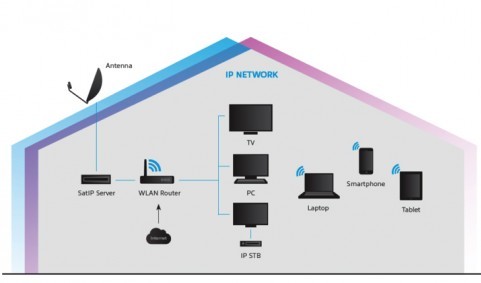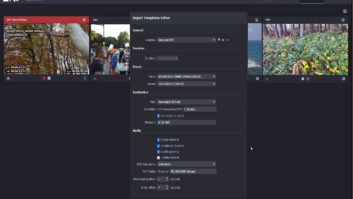
Thomas Wrede, VP Reception Systems, SES Astra
TV is still the predominant device to consume broadcast content in the home, however new devices such as tablets and smartphones are gaining in popularity for live TV. To address this trend, DVB will have to offer a technical solution to also reach these devices.
SAT>IP is an ideal complement to the DVB suite of broadcast standards (DVB-T2, DVB-C2, DVB-S2 and DVB-S2X) and facilitates the delivery of live broadcast (based on transport stream technology) onto IP networks in a very cost efficient manner, long before the broadcast industry has moved to native IP transmissions. DVB is in discussion with the SAT>IP Alliance to provide future extensions of the SAT>IP specification. It is assumed that such co-operation can be approved the autumn. This co-operation will also include common marketing activities for Sat>IP.
A first step in this direction is being demonstrated at IBC on the DVB booth (1.D81) where the technology is being used to deliver satellite and terrestrial content to handheld devices.
The SAT>IP Alliance was recently formed by DVB members Eutelsat, Hispasat, Nagra, MaxLinear, Panasonic and SES. The Alliance is a non-profit organisation open to other manufacturers, with the aim of co-ordinating and marketing SAT>IP technology worldwide.
Roughly 10 years ago satellite operator SES initiated discussions both internally and with industry partners about a Network Connected Tuner (NCT) which would output broadcasted video, audio and data streams directly onto an IP (in-home) network. The ultimate product design goal quickly turned into the concept of an IP-LNB, a Low-Noise Ku band block converter which would output live broadcast in IP format.
However, at that time the semiconductor industry was not yet in a position to provide cost efficient integrated high bandwidth A/D converters and product development efforts had to be put on hold.
In early 2010 R&D experts from Sky UK, Craftwork and SES joined forces to develop a protocol specification for taking live satellite broadcast onto IP networks and this initiative resulted in the creation of the SAT>IP communications protocol.
With SAT>IP, satellite-delivered DVB-S/S2 RF signals are demodulated and converted towards IP right at the point of reception in a SAT>IP server. Such a conversion may happen already in the satellite antenna itself (IP-LNB), close to the antenna (SAT>IP Multiswitch or converter) or in a master STB. Effectively SAT>IP servers remove the DVB-S/S2 layer and replace it with an IP transport layer. The same principle can also be applied to DVB-T/T2, DVB-C/C2 and DVB-S2X signals. The SAT>IP communications protocol was eventually extended to cover all DVB broadcast platforms including IPTV delivery.
SAT>IP represents a typical server and client model where the server strips off the DVB layer and puts the video, audio and data (SI, EMMs, ECMs, …) into IP format. It is based on existing IP standards such as UPnP for addressing and device discovery and RTSP/RTP for session control and streaming [Fig. 1].
SAT>IP is fully transparent to free-to-air and encrypted broadcast signals where traditionally the decryption takes place in the client device.
Given the fact that traditional broadcast CA solutions cannot be decrypted in software and thus have difficulties being used on modern IP devices such as tablets and smartphones, it becomes necessary for operators to implement a CA to DRM conversion after reception of their signals by SAT>IP servers [Fig. 2].
The first commercial implementation of such CA to DRM transcription is well on its way at the operator of the HD+ platform in Germany and will enable subscribers to watch encrypted programmes on their portable devices in the home.
The consumer benefit of SAT>IP is that this technology allows the watching of live TV on all kinds of IP devices connected to a home network. It also facilitates the “Future of TV is apps” vision which means that popular consumer devices do not need to have tuners anymore as these will reside in a server unit connected to the in-home IP network.
With SAT>IP no coax cable is required to view satellite, cable or terrestrial broadcast television on a second screen. CE manufacturer Panasonic has already integrated this technology in many of its flat screen TVs where the high-end models also incorporate a SAT>IP server.
SAT>IP was standardised by CENELEC in 2014 and is now supported by over 45 manufacturers who have launched close to 80 different SAT>IP server and client products.
Leading chip manufacturers have now launched full-band capture chips that can receive the entire satellite IF spectrum allowing a single-receiver design to offer multichannel service with channels anywhere in the spectrum as well as advanced features like fast channel change. Such chips provide up to 16 tuners on one SoC (System on Chip).
A recent development of a waveguide based Ku-band flat panel antenna with an integrated 32 channel SAT>IP server demonstrates what is technically possible today. For the camping market this flat panel antenna is available as a fully steerable (auto-pointing) version with an 8-channel SAT>IP server and 802.11ac WiFi capability.
The latest generation servers comprise up to 32 simultaneous front-ends and can serve the same number of client devices with individual programme streams. Of course these SAT>IP servers can process SD, HD and also Ultra HD programmes.







